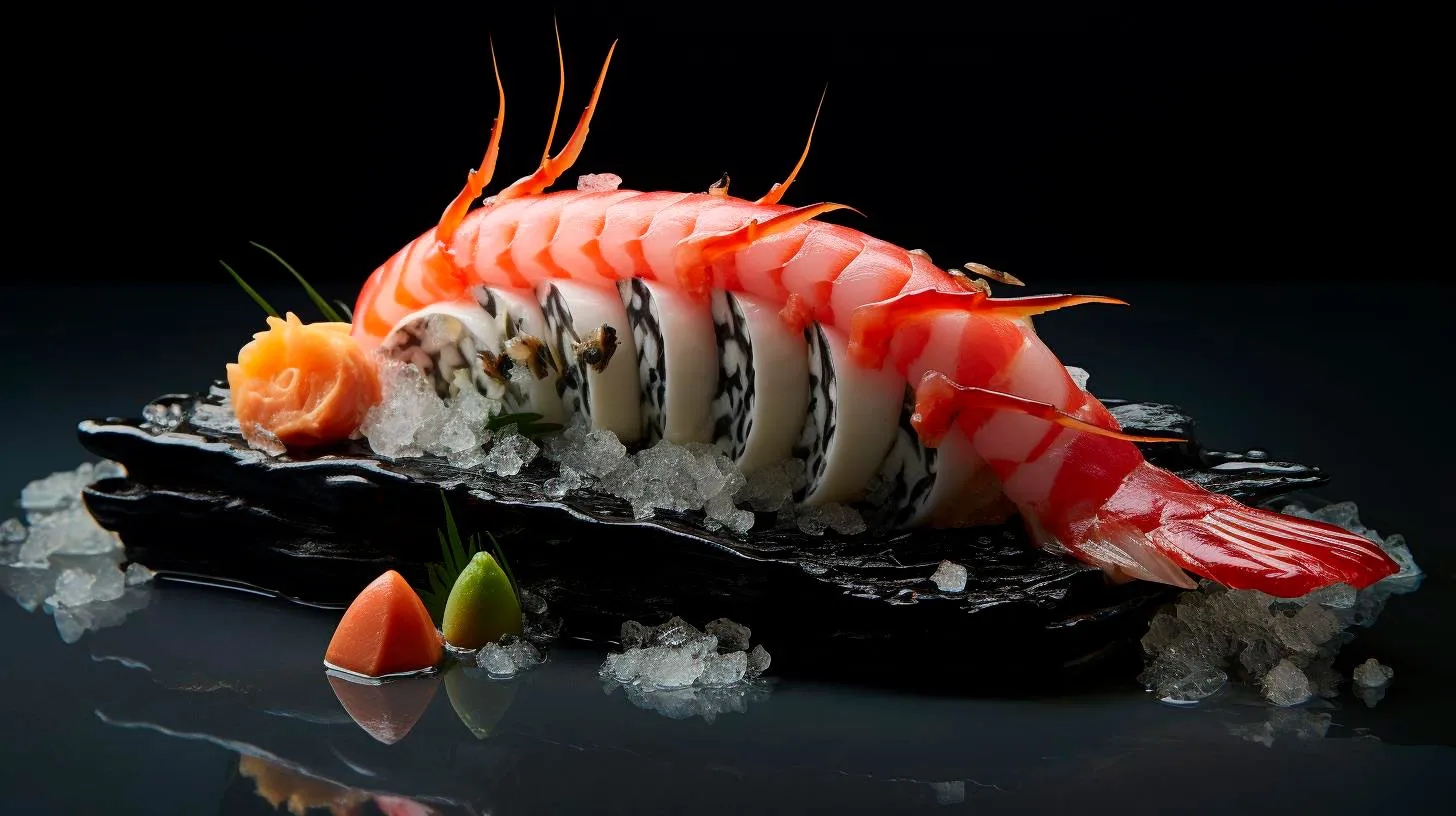Choosing Sushi and Sashimi for a Healthy Diet
In this article, we will discuss how to select the healthiest options and the benefits they offer.
Understanding Sushi and Sashimi
Before diving into the health benefits, let’s understand the difference between sushi and sashimi. Sushi is a traditional Japanese dish that consists of vinegared rice combined with various toppings, such as raw or cooked seafood, vegetables, and sometimes even tropical fruits. On the other hand, sashimi refers to thinly sliced raw seafood, typically served without rice.
Both sushi and sashimi are commonly enjoyed with soy sauce, wasabi, and pickled ginger. Now, let’s explore the reasons why choosing these dishes can be a healthy option.
The Advantages of Choosing Sushi and Sashimi
1. Rich in Nutrients
Sushi and sashimi are excellent sources of essential nutrients. Fish, one of the main ingredients, is a great source of high-quality protein, omega-3 fatty acids, vitamins, and minerals. Omega-3 fatty acids, in particular, are known for their heart-healthy properties and can help reduce the risk of cardiovascular diseases.
Key takeaway: Sushi and sashimi are packed with valuable nutrients like protein, omega-3 fatty acids, and essential vitamins and minerals.
2. Low in Calories
If you are mindful of your calorie intake, sushi and sashimi can be excellent choices. Compared to other types of cuisine or fast food options, sushi and sashimi are generally lower in calories. For example, a single piece of nigiri sushi typically contains around 40-60 calories, depending on the ingredients used. This makes it easier to maintain a healthy weight while still enjoying a delicious meal.
Key takeaway: Opting for sushi and sashimi can be beneficial if you are looking to manage your calorie intake without compromising on taste.
3. Rich in Antioxidants
Many ingredients used in sushi and sashimi are rich in antioxidants. Antioxidants play a crucial role in protecting our bodies against harmful free radicals, which can contribute to chronic diseases and aging. For instance, nori (seaweed) used in sushi is filled with antioxidants and has anti-inflammatory properties. Additionally, ginger, often served alongside sushi, is known for its antioxidant and anti-inflammatory benefits.
Key takeaway: Including sushi and sashimi in your diet can provide a healthy dose of antioxidants, protecting your body from oxidative stress.
Choose Smartly: Tips for Selecting the Healthiest Sushi and Sashimi
While sushi and sashimi are generally healthy options, following these tips will help you make even smarter choices:
- Opt for lean fish: Fish like tuna, salmon, and mackerel are excellent choices as they are rich in omega-3 fatty acids.
- Go for brown rice: If possible, choose sushi made with brown rice instead of white rice. Brown rice contains more fiber, vitamins, and minerals.
- Be cautious with sauces: Some sushi varieties, like tempura rolls, can be high in added sauces or mayonnaise. Stick to simpler options to avoid excessive calorie intake.
- Choose a reputable sushi restaurant: Ensure that the restaurant follows strict hygiene practices and uses fresh ingredients to avoid any potential health risks.
By considering these tips, you can make informed choices when selecting sushi and sashimi options from a menu.
Incorporate Sushi and Sashimi for a Healthier Diet
Sushi and sashimi can be a wonderful addition to your diet, providing a variety of flavors and health benefits. By making smart choices and considering the tips mentioned above, you can enjoy these delicious dishes while nourishing your body with essential nutrients.
Remember, moderation is the key. Enjoy sushi and sashimi as part of a well-balanced diet, and explore the wide range of options available to find your favorites. With their nutritional value and unique taste, sushi and sashimi can be a fantastic choice for a healthy and enjoyable dining experience.
Healthy Alternatives to High-Calorie Sushi Rolls
Fortunately, there are numerous healthy alternatives to high-calorie sushi rolls that still offer delicious flavors and nutritional benefits. In this article, we will explore some of these alternatives and provide key takeaways for making healthier choices when it comes to enjoying sushi.
1. Veggie Rolls
One of the healthiest alternatives to high-calorie sushi rolls is opting for veggie rolls. These rolls typically contain a variety of fresh vegetables like cucumber, avocado, carrot, and lettuce, providing essential vitamins, minerals, and fiber. Veggie rolls are typically low in calories and fat while still offering a satisfying crunch and a burst of flavors.
- Key Takeaway: Veggie rolls are a nutritious option that provides essential vitamins and minerals.
2. Brown Rice Rolls
Sushi rolls made with brown rice instead of white rice offer a healthier alternative. Brown rice is a whole grain that contains more fiber, vitamins, and minerals compared to white rice. This option helps to keep you feeling fuller for longer and prevents blood sugar spikes. Brown rice rolls are delicious and provide a nuttier flavor that complements the ingredients inside the roll.
- Key Takeaway: Opt for brown rice rolls to increase your intake of fiber and essential nutrients.
3. Sashimi
If you want to skip the rice altogether, sashimi is a fantastic low-calorie option. Sashimi consists of thinly sliced raw fish or seafood, providing an excellent source of lean protein. It is often served with soy sauce and wasabi for extra flavor. Sashimi is naturally low in calories and carbs, making it an ideal choice for those who are following a low-calorie diet or avoiding gluten.
- Key Takeaway: Sashimi is a high-protein, gluten-free option that is low in calories.
4. Seaweed Salad
Seaweed salad is a popular appetizer in Japanese cuisine and can be a healthy alternative to high-calorie sushi rolls. Seaweed is packed with essential nutrients like iodine, iron, and antioxidants. This salad is typically seasoned with sesame oil, soy sauce, and a hint of vinegar. It offers a unique taste and texture, providing a good source of fiber without adding excessive calories.
- Key Takeaway: Seaweed salad is a nutrient-rich alternative that adds variety to your sushi experience.
5. Temaki Rolls
Temaki rolls, also known as hand rolls, are a fun and healthier alternative to traditional sushi rolls. They are cone-shaped and filled with a variety of ingredients such as fresh fish, vegetables, and rice. Temaki rolls are often made with less rice and more filling, making them lower in calories compared to larger rolls. They are easy to assemble at home and allow you to customize the ingredients according to your preferences.
- Key Takeaway: Temaki rolls offer a customizable and low-calorie sushi option.
Conclusion
While traditional sushi rolls can be high in calories and fat, there are numerous healthy alternatives that still offer delicious flavors and nutritional benefits. Opting for veggie rolls, brown rice rolls, sashimi, seaweed salad, or temaki rolls can help you make healthier choices without compromising on taste. By incorporating these alternatives into your sushi experience, you can enjoy a satisfying meal while maintaining a balanced and nutritious diet.
Remember, it’s essential to consider your personal dietary needs and preferences when choosing your sushi options. With these healthier alternatives, you can continue to savor the delights of sushi while making choices that align with your health goals.
Tips for Customizing Sushi and Sashimi to Fit Your Diet
Whether you are following a specific diet plan or have certain allergies or preferences, here are some tips to help you customize sushi and sashimi while keeping them delicious and nutritious.
1. Opt for Whole Grain Rice
Traditionally, sushi and sashimi are made with white rice. However, if you are looking for a healthier option, consider swapping it with whole grain rice. Whole grain rice is packed with more fiber, vitamins, and minerals compared to white rice. It helps in better digestion, provides sustained energy, and keeps you fuller for longer.
2. Choose Lean Protein Options
Protein is an essential component of sushi and sashimi. It is usually derived from fish, seafood, or tofu. While sushi and sashimi offer a variety of protein options, it’s essential to choose lean sources to keep your meal low in fat and calories. Opt for fish options like tuna, salmon, or yellowtail, which are rich in omega-3 fatty acids and protein. If you prefer vegetarian options, tofu or avocado can be a great source of protein.
3. Incorporate Colorful Vegetables
Sushi and sashimi are not just about the protein; they can also be a great platform to incorporate more vegetables into your diet. Along with the traditional cucumber, consider adding colorful vegetables like carrots, bell peppers, or even leafy greens like spinach or kale to your sushi rolls or sashimi platters. Vegetables are packed with essential vitamins, minerals, and antioxidants, adding more nutritional value to your meal.
4. Use Low-Sodium Soy Sauce
Soy sauce is a staple when it comes to enjoying sushi and sashimi. However, traditional soy sauce can be high in sodium, which may not be suitable for everyone, especially those with high blood pressure or other health concerns. Opt for low-sodium soy sauce or tamari as a healthier alternative. You can still enjoy the savory flavor without compromising your dietary requirements.
5. Experiment with Alternative Wrappers
If you are looking to reduce your carbohydrate intake or avoid gluten, consider experimenting with alternative wrappers for your sushi rolls. Instead of traditional seaweed wrappers, try using thinly sliced cucumber, lettuce leaves, or even soy paper. These alternatives not only offer a different texture but also add more variety and creativity to your sushi customization.
Key Takeaways
- Customizing sushi and sashimi allows you to cater to your specific dietary needs and preferences.
- Swapping white rice with whole grain rice increases fiber and nutrient content.
- Choose lean protein options like fish or tofu to keep your meal low in fat and calories.
- Incorporating colorful vegetables adds more vitamins, minerals, and antioxidants to your meal.
- Opt for low-sodium soy sauce or tamari to reduce sodium intake.
- Experiment with alternative wrappers like cucumber slices or lettuce leaves for variety and dietary restrictions.
Customizing sushi and sashimi to fit your diet can be a fun and creative process. By making simple substitutions and additions, you can transform these popular Japanese dishes into a nutritious and satisfying meal. Remember to always prioritize your dietary requirements and make choices that align with your health goals. Enjoy the process of customizing your sushi and sashimi while exploring new flavors and combinations.
How to Identify Fresh Ingredients in Sushi and Sashimi
In this article, we will dive into the key indicators of freshness in sushi and sashimi, enabling you to make informed choices and enhance your dining experience.
1. Appearance
One of the primary ways to identify fresh ingredients in sushi and sashimi is through their appearance. Here are some visual cues to look out for:
- Color: Fresh fish should have vibrant, natural colors. For example, tuna should be deep red, while salmon should have a rich orange hue.
- Texture: The flesh of the fish should be firm and shiny, indicating that it has been properly handled and stored.
- Clear Eyes: Whole fish should have clear, bright eyes. Cloudy or sunken eyes could be a sign of poor quality or age.
2. Smell
The smell of sushi and sashimi can also provide valuable clues about the freshness of the ingredients. Fresh seafood should have a clean, slightly oceanic scent. Avoid any fishy or ammonia-like odors, as they may indicate that the ingredients are not fresh.
3. Taste
The taste of sushi and sashimi is perhaps the most important factor in determining the freshness of the ingredients. When eating sushi, pay attention to the natural flavors of the fish. Fresh fish should taste clean, slightly sweet, and melt in your mouth. If the fish tastes fishy or has an unpleasant smell, it might not be fresh.
4. Sourcing
Knowing the source of the ingredients is crucial in identifying freshness. Choose reputable sushi restaurants or suppliers that have a reputation for serving high-quality seafood. Ask where the fish is sourced from and whether it is handled and stored properly to maintain freshness.
5. Time of Year
Understanding the seasonality of certain fish can also help in identifying freshness. Different species of fish have peak seasons when they are most abundant and flavorful. For example, during the winter months, fatty fishes like tuna and yellowtail tend to be at their best. Sushi restaurants that prioritize seasonal ingredients are likely to serve fresher options.
Key Takeaways
- Identifying fresh ingredients in sushi and sashimi is essential for a truly enjoyable dining experience.
- Pay attention to the appearance, smell, and taste of the fish to determine its freshness.
- Choose reputable restaurants or suppliers that prioritize quality and freshness.
- Understanding the seasonality of fish can help you make informed choices.
By using these tips, you can confidently identify fresh ingredients in sushi and sashimi, ensuring that every bite is a delight to your taste buds. Don’t compromise on quality when indulging in these exquisite Japanese dishes. Enjoy the flavors, textures, and health benefits that only the freshest ingredients can provide!


